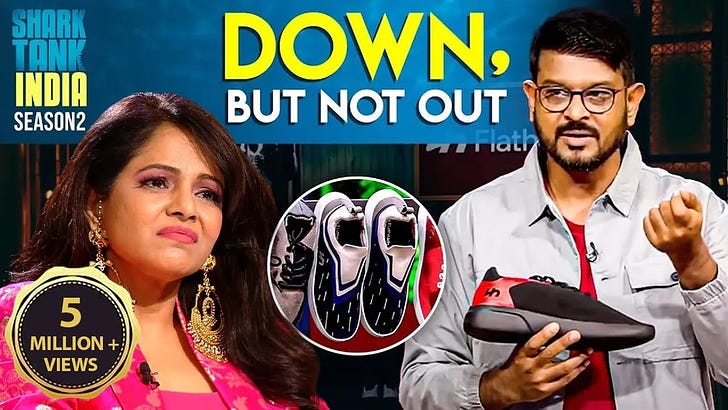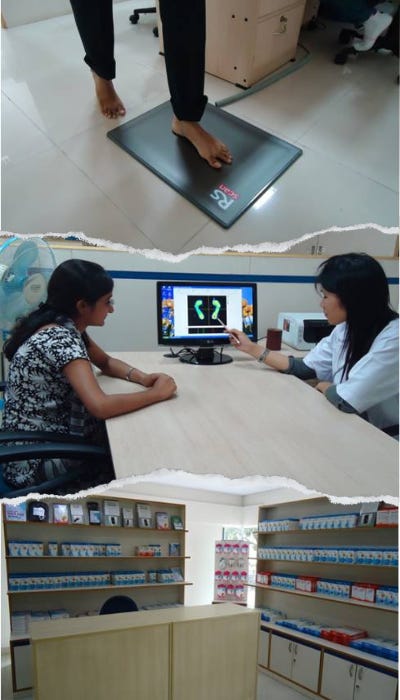Here’s how an optician works: you get your eyes tested, a prescription is generated, and you choose a frame and the quality of lenses.
Now imagine that, but with shoes: You get your gait analyzed on a machine, a shoe insert is prescribed, and you pick it up off the shelf or get it customized. This was my pitch for Walk Well, a concept I launched in Bangalore in 2011. I was 23, fresh out of software engineering and convinced that I was the next Dr. Scholl.
The foot scanner was sourced from Belgium, and cost a pretty penny. We’re a business family, so all I had to do was convince the board- my father and cousins- that this was a worthwhile expansion. Their experience was (and is) in Pharma distribution, so they took my word for it.
Already the seeds of my doom were sown here- no accountability, no verification of my business plan, and a sizeable amount of capital. I didn’t even know how much space I needed, or what the potential market size could be. I was the anointed one, the smartest of the lot who had topped all through his life, finally stepping up to claim his rightful place in the world of business. What could possibly go wrong?
Yeah, it wasn’t pretty.
I picked a spacious office, 1200 square feet at a busy intersection with high visibility. The scanner and retail area could’ve comfortably fit in 1/4th that space. I then furnished it with high-quality custom-made furniture, and paid rent for four months while it was prepared on site by a crack team of carpenters. Did I hire a designer? Of course not! I was smart enough to design it myself. Did I have prior experience with interior design? Nope.
Since this was a nascent concept, I decided to offer the gait analysis free of charge. I figured- the machine itself had no consumables, and I was paying the physiotherapist for their time anyways. The margins on the products were enough to cover up the difference.
The first few months were heady- optimism for a new venture, curious footfalls and decent sales. One weekend, we received local newspaper coverage and the place was packed to the brim with curious customers. This felt like validation of the concept- we had arrived.
We ran into a roadblock quite early on- people agreed with the diagnosis, were ready to purchase the insoles but not keen on wearing shoes, preferring open toed slippers or sandals. I designed and procured a sandal with a removable footbed, which allowed the insole to be swapped in. High on functionality, the sandals were aesthetically disgusting, with some customers flat out telling us they’d rather be in pain than wear those.
Another learning was: footwear inventory management is a nightmare. Sizes, colors, genders, it all gets out of hand very soon.
Sales were ok-ish at this point. Nowhere close to breakeven though. The problem was, we were catering to many different segments- athletes, diabetics, people with foot pain. But we never committed to any one lane, so our marketing and our products were a hodge-podge. Our solutions were wide, but shallow.
About a year in, one of my oldest friends visited me. He’d been working at an IT company, and found it stifling. He wanted to strike it out on his own. On an impulse, I asked him to come spend some time in Walk Well, an internship of sorts. Over the next few months, he attended customers, made cold calls and gave me company in the most boring, stifling part of retail- waiting for people to walk in.
There would be days when the whole team- the physio, the salesman, the receptionist, the security guard, my friend and I- would come in the morning, sit for eight hours, trying and failing not to yawn, and leave in the evening. Without a single customer the entire day.
Despite all these glaring red flags, my vision was to have a hundred stores like this one day. Sure I’d made a few mistakes with this one, particularly the high rent. But this was the flagship, the first of many more to come. It had to look and feel prestigious. Like many founders, I wrongly believed that scale would automatically improve my unit economics.
By then, my friend too had succumbed to my vision, and volunteered to be the first franchisee. He believed deeply in the brand, and wanted to demonstrate that it can scale. We identified a small space in North Bangalore (The first one was in the South) and made sure not to repeat the mistakes I’d made. So we made brand new ones. The rent was low, the space was small, the furniture sparse. But it was in a bylane in a residential locality with very little traffic, foot or otherwise.
For a few painful months, we tried to keep both stores alive. Finally, my friend gave up. He asked me what my plan was for his store. To my eternal shame, I told him that he was being impatient. That it was too soon to evaluate viability. I just didn’t want to admit defeat.
I didn’t realize that he had put all his savings into this, and that he would soon have trouble meeting his rent. I lacked empathy because I had never had to face that issue, yet. All I had to do was show up on the first of every month, hat in hand, at my father’s office door, seeking another mini-bailout.
My friend and I had a falling out. He shuttered the store, presumably salvaging what he could. His linkedin has no mention of those days. And, I’m sorry to say, but we’re no longer in touch. A fifteen year friendship down the drain.
This was 2013.
I finally shut shop in 2015. I had done everything I could for those two years, including taking up pharma distribution on the side, just to keep the lights on. I hadn’t made any money in four years.
You’re probably wondering, why? Why, when it was so painfully obvious that this wasn’t working, did I insist on keeping it going?
A few reasons.
One, my business was my identity. This was who I was- an entrepreneur. And if I wasn’t that any more, who was I? Second, I had never failed before. Ever. How does one cope, especially in a merchant culture where your work and your income decide your social worth? Third, I had literally put this together myself. I remembered every nail that went into my coffin (and the furniture). It was painful beyond words to watch it get torn up when we finally vacated.
Once the interring was done and the mourning period was over, I felt a lightness- for the first time in almost half a decade, I was untethered. Free to do whatever I wanted, be whoever I wanted. I was also acutely aware of how lucky I was, that I got to start this, and pursue it unprofitably for years without having to worry about food or shelter or having to provide for my family. That was my privilege, something I had never considered before.
So why are we doing a sob story today, Indian Idol style?
To provide context for one of my favorite pitches on Shark Tank India- Flatheads, by Ganesh Balakrishnan. A serial entrepreneur, ex IIT-B, ex Bain & Co, Ganesh ticks all the right boxes. He cofounded Flatheads, a sneaker brand, in 2019.
Having raised funding of ₹10 crores (About $1.5m) since inception, Flatheads was out of money at the time of the pitch.
I highly recommend you watch the video, which I’ll link below. Consider the excellent points the sharks raise. Especially Vinita Singh about what happens when you raise too much money before you have product-market fit. And Aman Gupta’s advice to shut shop, work for someone else and come back to entrepreneurship with those learnings.
And above all, I commend Ganesh for having the courage and humility to understand that his best effort had fallen short. And that it was OK to admit defeat. Only then can the next chapter start, once the current one ends.
EDIT: I’ve written a part two to my story. Check it out here.
This post is for information purposes only, and should not be interpreted as investing advice. The author may hold positions in the securities discussed.






Delightful post! Being vulnerable and owning up to your mistakes, all with a touch of humour and some lovely writing made this post a pleasure to read. Here for more of this!
This is fictional right? You want me to believe that there exists a part in Bangalore which is low on traffic? Hah! Good try. But no.
Apart from my minute and dare I say so myself a smart observation above, I liked the post. You write so well it hurts that you don’t do it more frequently. No no please don’t let this be a pressure of any sort. I mean why would you write when you can, not write, I get it.
No please don’t write, it’s okay. I will go and scroll stratecherry up and down just so someone around me thinks I am too smart. Tum khush raho yaar. Mat likha karo.